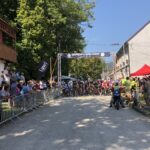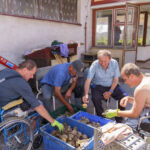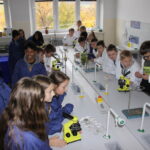Kláštor pod Znievom, Slovakia
Kláštor pod Znievom is an approximately 3,900-hectare municipality in the central Slovakian region of Žilinský kraj. It has around 1,750 inhabitants. The town with municipal rights is situated in a mountain valley by the Vrica stream. The district town of Martin is 20 kilometers away. There are 214 jobs in 76 local businesses and companies compared to 78 unemployed. There is a connection to public transport by bus and train in the vicinity. The nearest motorway junction is around 25 kilometers away.
The municipality has a rich history, shaped by a medieval castle, a Premonstratensian monastery and the Slovak Catholic Patronate Gymnasium. The community also owes many of its buildings to the Jesuits, for example the Passionsweg in the baroque chapel, the chapel of St. Margit and the excavation of the canal through the middle of the village square. In addition, the Jesuits set up a pharmacy in the village and began to produce medicinal products from herbs, as well as to prepare oils and process saffron. There is still a community herb garden in the community today. Kláštor pod Zvievom does not have ideal conditions for growing classic agricultural products, yet the first botanical garden in Europe was established in 1578.
After starting a development process in 2015 with the involvement of the citizens, the municipality of Kláštor pod Znievom managed to stabilize the municipal finances, reduce operating costs in public buildings, create a development plan and improve infrastructure, health care and environmental protection. The high subsidies gained for the extensive investments are remarkable. The participation of the population is ensured through information events and questionnaires, and information is passed on through the website and the community newspaper. The rural exodus has been contained, the population and the number of jobs are increasing.
Prioritized and important structural measures have been tackled. Currently 35 percent of the local area is already canalized, with continuous work being done on the further expansion of canalization, the expansion of flood protection, the rehabilitation of local streets and sidewalks and the repair of public green spaces and cycle paths. In the course of the refurbishment program, numerous public buildings and cultural monuments were also modernized and energy-optimized. Above all, heat pumps and photovoltaic systems were built to reduce operating costs. The street lighting was also renewed.
The community has reorganized waste disposal with its own company and implemented waste management with an innovative seal system to reduce waste. A composter was distributed to each household for their own composting of biological waste, containers for separating waste were set up and a waste collection yard set up. The municipality initiated the revision of the development plan to improve and control the settlement development, whereby the rural settlement character and the typical cultural landscape are a primary focus. New building plots for single-family houses should encourage the influx of young families.
To strengthen the economy, the ecological medicinal plant cultivation was revived, including local tea varieties, and the entire area of Kláštor pod Znievom being certified as an organic area for medicinal herbs. Other projects in this area are the “House of Herbs and Oil Makers” or the communal herb garden. The knowledge of these traditions is already conveyed to the children as members of the next generation in kindergarten and school. Oil preparation, saffron processing and honey production, local milk and bakery production as well as livestock farming and regional marketing also strengthen the economic potential. Finally, the Kláštorná company also contributes by filling the “Klaštorny” mineral water from the local mineral spring in 100 percent recyclable bottles. Tourism is also being promoted, as it forms a clear focus for the future and will provide additional jobs. A good basis for this is the proximity to the national park and bird sanctuary Malá Fatra. The market with regional products and the annual fair also bring guests to the community. In the future, the Zniev castle ruins will also be revitalized to increase cultural tourism.
Modern social facilities have been created. A particular source of pride is the “Good Shepherd” community, which offers shelter in the old monastery for around 400 homeless people, former convicts and residents of children’s homes. These people find employment in agriculture and dairy production as well as in the maintenance of public areas and they are actively integrated into community life. In addition, abused women and children find a safe haven in the “Dawn” women’s shelter. Various small social projects for all generations are available to the population. Emergency aid, for example for Ukrainian refugees, is also provided.
Education is very important in the community. In kindergarten and elementary school, high quality education following modern educational concepts is offered. Attention is also paid to good teaching materials and equipment. Environmental protection is also an important aspect of the curriculum. The establishment of a student parliament, participation in school competitions and language support for children with a different mother tongue are evidence of community initiatives in the field of education, as is the establishment of a public library with more than 10.000 books. The healthcare system will be secured by the general renovation of the medical center, including the construction of a pharmacy and a new partnership for the medical center. The employment of family doctors is planned.
Through the involvement of active civil communities and religious organizations, an effective development process was launched in Kláštor pod Znievom, in the course of which it was possible to make exceptionally good use of available resources and initiate the construction of a functioning infrastructure. The main goal was and is to make the community, which looks back on a rich history, fit for the 21st century by constantly improving the quality of life – something that is clearly visible to both locals and guests.
Evaluated: 2022








